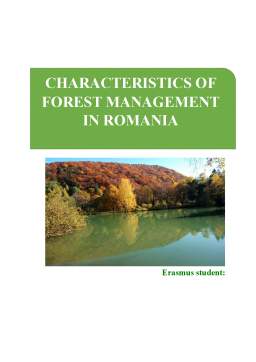Cuprins
- I. Introduction
- II. Basic characteristics of Romanian ecosystems
- 1. Climate and precipitations
- 2. Hydrology
- 3. Landforms and ecoregions
- 4. Fauna and flora
- III. General characteristics of forests
- 1. Evolution of forest cover
- 2. Main forest regions
- 3. Forest tree species
- IV. Forest management in Romania
- V. Forest resources in Romania
- VI. Effect of climatic change on forestry in Romania
- VII. Role of forestry in general biodiversity in Romania
- VIII. Forestry strategy in the future
- References
Extras din proiect
I. Introduction
Romania is a state located in south-eastern central Europe, on the lower course of the Danube, north of the Balkan Peninsula and on the north-western shore of the Black Sea. In its territory is located almost the entire Danube Delta and the southern and central part of the Carpathian Mountains. It borders Bulgaria on the south, Serbia to the southwest, Hungary to the northwest, Ukraine to the north and east, and the Republic of Moldova to the east, and the Black Sea shore is to the southeast.
Img. 1 - Position of Romania
Throughout history, different parts of today's territory of Romania were in the composition or under the administration of Dacia, the Roman Empire, the Ottoman Empire, the Russian Empire, and the Austro-Hungarian Empire.
Romania emerged as a state, led by Alexandru Ioan Cuza, in 1859, by the union between Moldova and Wallachia, preserving the autonomy and tributary status of the Ottoman Empire, which the two Principalities had. It was recognized as an independent country 19 years later. In 1918, Transylvania, Bucovina and Bessarabia joined with Romania, forming Great Romania or Interwar Romania, which had the largest territorial expansion in Romania's history (295,641 km).
On the eve of the Second World War (1940), Great Romania, under the pressure of Nazi Germany, ceded the territories of Hungary (Northeast of Transylvania), Bulgaria (Cadrilater) and Soviet Union (Bessarabia, Herta and Northern Bukovina). After the abolition of Antonescu 's dictatorship on 23 August 1944, Romania withdrew from the alliance with the Powers of the Axis, passing on to the Allied Powers (England, the United States, France, and the Soviet Union). Through The Peace Treaty of Paris signed on February 10, 1947, from the ceded territories of the former Great Romania, recovered Northern Transylvania.
After the abolition of the communist regime installed in Romania (1989) and after the dissolution of the Soviet Union (1991), the state initiated a series of economic and political reforms. After a decade of economic problems, Romania introduced new general economic reforms (such as the one-off tax rate in 2005) and joined the European Union on 1 January 2007 .
Romania is a semi-presidential republic. It is the ninth state by surface area (238 397 km² ) and seventh by population (over 20 million inhabitants) among the Member States of the European Union . The capital of the country, Bucharest, is also its largest city and the sixth EU city by population (1.9 million inhabitants). It was Romania's turn to designate a city as European Capital of Culture, for 2007, being elected Sibiu, and for 2021, being elected Timisoara . Romania is a member of international organizations, including: UN 1955, CoE 1993, the European Union from January 1, 2007, NATO on March 29, 2004, OSCE , OIF 2003 Latin Union since 1980, and of economic institutions: Group World Bank, IMF since 1972, EBRD since 1991; and is a candidate for accession to the OECD.
Bibliografie
- "Small Encyclopedia of Romanian Culture and Civilization", Dan Petre, International Literature Publishing House, 2005
- : ”Romania: State - Nation - Language”, Michael Metzeltin, Bucharest, Univers Enciclopedic Publishing House, 2002
- ”The rivers of Romania. Hydrological monograph”, Constantin Diaconu, Bucharest, 1971, 752 p.
- ”Geography of Romanian Waters”, Ujvari J., Scientific Ed., Bucharest, 1972
- ”Physical Geography of Romania - Climate, Water, Vegetation, Soils”, Patru Ileana, Bucharest: University Publishing House Bucharest, 2006, pp. 35-111
- ”Integrated management of forestry resources”, Mihai-Leonard Duduma, University Ștefan cel Mare of Suceava, 2014
- ”Romanian`s forests” - https://www.capital.ro/ - accessed on 7 th October 2018
- ”The National Forest Strategy 2018 - 2027” - http://www.mmediu.ro - accessed on 7 th October 2018
- ”About the importance of forests and their creautres” - http://www.turainnatura.ro - accessed on 7 th October 2018
Preview document
Conținut arhivă zip
- Characteristics of forest management in Romania.docx



















